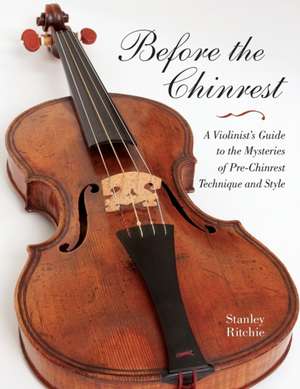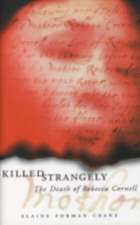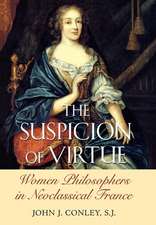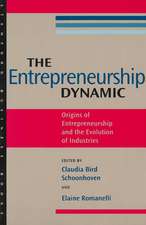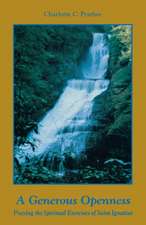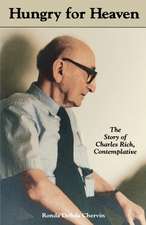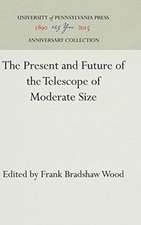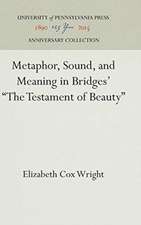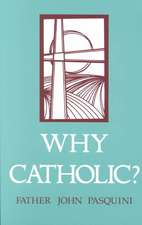Before the Chinrest – A Violinist`s Guide to the Mysteries of Pre–Chinrest Technique and Style
Autor Stanley Ritchieen Limba Engleză Paperback – 15 iul 2012
Preț: 224.61 lei
Nou
Puncte Express: 337
Preț estimativ în valută:
42.98€ • 45.96$ • 35.84£
42.98€ • 45.96$ • 35.84£
Carte tipărită la comandă
Livrare economică 18 aprilie-02 mai
Livrare express 13-19 martie pentru 35.53 lei
Preluare comenzi: 021 569.72.76
Specificații
ISBN-13: 9780253223180
ISBN-10: 0253223180
Pagini: 168
Ilustrații: 260 music exx. and 1 b&w illustration
Dimensiuni: 213 x 278 x 10 mm
Greutate: 0.43 kg
Editura: MH – Indiana University Press
ISBN-10: 0253223180
Pagini: 168
Ilustrații: 260 music exx. and 1 b&w illustration
Dimensiuni: 213 x 278 x 10 mm
Greutate: 0.43 kg
Editura: MH – Indiana University Press
Cuprins
Preface and AcknowledgementsHow to Support the Pre-Chinrest ViolinI. Right Hand Technique General Observations 1. Tone Production Basic Right-HandTechnique The Importance of Arm Weight The Use of Arm Weight; 2. Bow-Strokes Liftedstrokes Slurred notes Retaking Z-bowing Martelé and Spiccato Sautillé BariolageOndeggiando; 3. Chordal Technique; 4. Bow Division; 5. Swift-Bows; 6. CombinationStrokesII. Left-Hand Technique 7. Position-Changing Exercises Some Basic ConceptsThe Position Of The Left Hand The Swing Shifting Half-position VibratoIII. Interpretation 8. Expression Affect and rhetoric The role of analysis The importanceof the bass-line The tyranny of the barline The significance of metre Shaping notesand gestures Beware of the beam! The trouble with notation The reality of rubato; 9.Dynamics and Nuance Harmony Melody Figures of musical speech (i) Repetition (ii)Sequences (iii) Tessitura (iv) The question (v) The exclamation (vi) Silence; 10.Tempo Metrical symbols Harmonic motion Technical complexity Affective wordsCautionary and qualifying words Baroque dance movements; 11. Ornamentation SymbolicNotated ornaments Un-notated ornaments; 12. Baroque Clichés The classic cadentialformula Slurred articulations The hemiola Pulsations Suspensions SyncopationsMelodic accents "Down-downs" The ultimate Baroque clichéIV. Technique and Practice Guide 13. Tuning A word about intonation Tuning Difference tones Difference tone exercise Visualizing Warm-up exercises A shifting exercise; 14. ExercisesStarting on First Finger Scales Broken Thirds Double-stopped Thirds Sixths OctavesFingered Octaves Tenths Arpeggios; 15. Exercises Starting on G Scales Broken ThirdsDouble-stopped Thirds Sixths Octaves Fingered Octaves Tenths Arpeggios; 16. HalfPositionNotes; Index
Recenzii
"Useful and elegantly written, Stanley Ritchie's book will be a most valuable resource to accomplished modern violinists wishing to learn to play the baroque violin." Marc Destrubé, violinistBefore the Chinrest is aimed at modern violinists and viola players who are curious to learn about technique and style as understood and practised by their seventeenth and eighteenth-century predecessors, so it is designed as a practical guide and includes a wealth of information, musical examples and technical exercises Ritchie divides the book into four sections: right-hand technique, left-hand technique, interpretation, and a technique and intonation practice guide. I found myself in agreement with a great number of his points about matters technical and interpretative, and many of his technical exercises would be extremely helpful to those new to period playing. However, I would have expected more information on how the baroque violin differs in its setup from the modern and how the bow developed over the years, as well as some advice as to how to go about getting hold of the instruments, bows and gut strings Before the Chinrest is highly recommended for what is included, but disappointing as to what is omitted. My recommendation to modern-trained players would be to buy Judy Tarlings Baroque String Playing for Ingenious Learners as an ideal reference book for this music and then use this new book for a more detailed practical guide to playing the instrument.-Classical Music, Dec 2012
"Useful and elegantly written, Stanley Ritchie's book will be a most valuable resource to accomplished modern violinists wishing to learn to play the baroque violin." Marc Destrube, violinist "Before the Chinrest is aimed at modern violinists and viola players who are 'curious to learn about technique and style as understood and practised by their seventeenth and eighteenth-century predecessors', so it is designed as a practical guide and includes a wealth of information, musical examples and technical exercises... Ritchie divides the book into four sections: right-hand technique, left-hand technique, interpretation, and a technique and intonation practice guide. I found myself in agreement with a great number of his points about matters technical and interpretative, and many of his technical exercises would be extremely helpful to those new to period playing. However, I would have expected more information on how the baroque violin differs in its setup from the modern and how the bow developed over the years, as well as some advice as to how to go about getting hold of the instruments, bows and gut strings... Before the Chinrest is highly recommended for what is included, but disappointing as to what is omitted. My recommendation to modern-trained players would be to buy Judy Tarling's Baroque String Playing for Ingenious Learners as an ideal reference book for this music and then use this new book for a more detailed practical guide to playing the instrument."-Classical Music, Dec 2012
"Useful and elegantly written, Stanley Ritchie's book will be a most valuable resource to accomplished modern violinists wishing to learn to play the baroque violin." Marc Destrube, violinist "Before the Chinrest is aimed at modern violinists and viola players who are 'curious to learn about technique and style as understood and practised by their seventeenth and eighteenth-century predecessors', so it is designed as a practical guide and includes a wealth of information, musical examples and technical exercises... Ritchie divides the book into four sections: right-hand technique, left-hand technique, interpretation, and a technique and intonation practice guide. I found myself in agreement with a great number of his points about matters technical and interpretative, and many of his technical exercises would be extremely helpful to those new to period playing. However, I would have expected more information on how the baroque violin differs in its setup from the modern and how the bow developed over the years, as well as some advice as to how to go about getting hold of the instruments, bows and gut strings... Before the Chinrest is highly recommended for what is included, but disappointing as to what is omitted. My recommendation to modern-trained players would be to buy Judy Tarling's Baroque String Playing for Ingenious Learners as an ideal reference book for this music and then use this new book for a more detailed practical guide to playing the instrument."-Classical Music, Dec 2012
Notă biografică
Descriere
Unlocking the secrets of early violin performance
